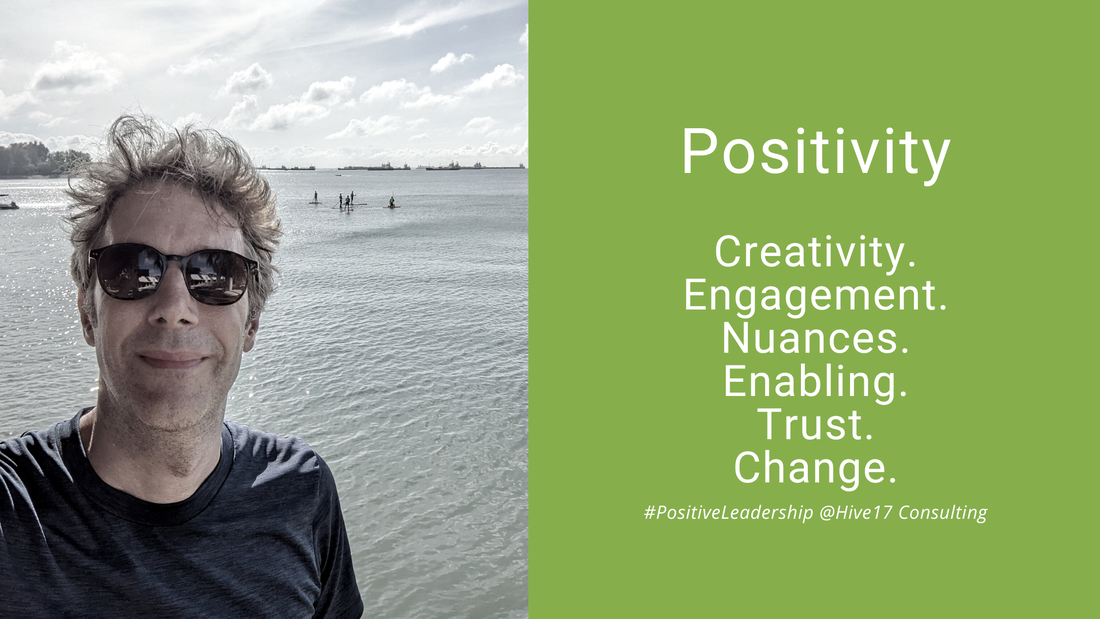|
Friends often come to me and say, 'Hey Tim, you are so positive all the time - how are you doing that?'. One could say, oh, that is simply my character. It might be, though for me it is a deep conviction that positivity is the better approach to life. What led me to this conviction? There are a few elements which I would like to elaborate on here.
First is simply neuroscience: when people are exposed to negative emotional situations then the reptilian brain reacts with freeze, fight or flight. When we are in a positive emotional state, we can thrive; we are good at heuristic tasks, more curious and as a result more productive. Based on this and what I have seen in multiple workshops and real life situations, when we enjoy the situation and are in a good mood, creativity rises, brainstorming sessions work better, we easily solve problems and are overall the engagement and motivation is getting high. Further, I discovered that nothing is simply good or bad. People, processes, systems, situations always have positive and(!) and negative sides. Even a specific action typically leads to advantages and disadvantages. Life in general is nuanced. Are there really errors, mistakes, burning platforms, issues, problems? Or shall we rather say that something has led to an outcome we didn't expect and anticipated. As a result, we always have the possibility of finding something positive about any situation. And yes, that doesn't mean we naively ignore the negative impacts. We have all been in situations where we ourselves get annoyed with something or our counterparts are fuming. With these emotions we are getting defensive, losing the ability to think critically. Positivity allows us to reduce limiting emotions. Prepare a foundation where we can work together towards a better outcome. Then there is trust; an essential element for good collaboration. In order to allow people to open up to each other, a positive environment helps a lot. And, in my experience in change management, positivity makes transformation much much easier. Allows the adaptors to become more receptive and reduces the negative impact any change is creating. How can you become a positive person? First, human- and data-centric approaches like design thinking and lean management allow us to be more considerate, curious and nuanced. Mindfulness helped me a lot to become more balanced and view things in a more down-to-earth way. I love the principles of appreciative inquiry. And I can only encourage practicing more positive leadership. What are your experiences with positivity?
0 Comments
We heard this a lot - especially in the current pandemic: stress is causing our brain to react with flight, freeze, faint or fight. And this reaction is blocking our creativity and problem-solving capability. Stress can come from so many directions: uncertainty, feeling threatened, lack of job security, work overload, lack of control, feeling insecure, feeling lost...
Neuroscience tells us that a positive emotional state restores this creative thinking which allows us to solve problems and accelerate the much needed innovation. As a leader, we can switch the work environment from one of fear & challenges, to one where we can discover great opportunities. This will also strengthen trust and self-esteem. Here is one surprising source for this positive environment. According to this IMD article is humour! Feena May describes in The incredible lightness of being: use humor to inspire your team during a crisis "humour as a leader's capacity, ability and willingness to share themselves in service of the situation" with lightness of spirit, kindness and presence. As so often, the intent is important. We want to use humour in order to enlarge and open the space between people; take them out of their shells and caves and bring them together with purpose and fun. Humour is not the same as jokes; these are often making fun of a certain group of people, which is counter-productive. The silent clown can be an inspiration; the apparently simple acts of holding space, creating connection and encouraging exchange. And often, a simple smile and light-hearted comment by a leader can create positivity which removes the stress and uncertainty. Feena mentions three reflection points:
There are many ingredients to accelerate excellence, drive productivity and strengthen innovation. One of them is humour which creates fun and collaborative environment based on positive leadership. Neuroscience tells us that we are more creative and productive when we are working in a positive emotional state. As a leaders, this means we are responsible to create an environment which excites people to work in - establish a feeling of enjoyment and pride. Psychological Safety plays a big part in creating this environment. This is not a hygiene topic; rather it will allow people to deliver more value.
Two interesting articles are referenced in an article from 'CNBC Make It': Google determines psychological safety as the most important quality for success; Gallup reports that increased psychological safety leads to 12% increase in productivity. This is a worthwhile endeavour. And what does it take?
Which routines do you establish as a leader to create an appreciative working environment? Source: ‘Psychological safety’ at work improves productivity–here are 4 ways to get it, according to a Harvard expert Neuroscience has been becoming very interesting in explaining how our brain works - and hence how we behave. This article by Paul J. Zak took this practice and explained trust - not only how it works in the brain; also how we can influence this system as a leader.
Why is trust important? Comparing to low-trust companies, people at high-trust companies report:
Zak went through 10 years of experimenting this topic and discovered the following. Our brain is producing a chemical called oxytocin; when more of this substance is present in our brain, we tend to be more trustworthy. This means, the amount of trust we put into the people around us is influenced by the presence of oxytocin. His research went further and he experimented what are the levers that influence the level of oxytocin in our brains. How can we as leaders create an environment for trust - proven by neuroscience. Here are the eight findings.
How are you struggling to become a trustworthy leader? Share your story. Thank you, Daniel Benes, for sharing the article: On a daily basis, we are pushing our teams for speed and cost. Do we get better, sustainable results? Neuroscience tells us we might be wrong in doing so.
Without going too deep into neuroscience, establishing new mindsets is literally about rewiring our brains. Neurotransmitters from new paths in our mind; this is creating new learning and helps us to transform. Two conditions support this rewiring. Our brain will only be able to rewire when we are in a positive emotional state; we are open to new thoughts and discoveries. In addition, the new neural paths will be build over time based on repeating the new patterns. One simple and effective way to start is to visualise the positive outcome and repeat towards achieving it. Instead of creating pressure, engage with our people and discuss with them how success looks like and what actions we think will lead us to this success. And let's have fun along the way. Source: The Neuroscience of Habits, by Brigitte Najjar (Udemy) |
Subscribe
Receive our monthly themed summaries of our thoughts: click! TimTim is a change practitioner in the area of innovation and excellence. He is working with teams to accelerate innovation, collaboration and agility. Categories
All
Archives
July 2024
|






 RSS Feed
RSS Feed